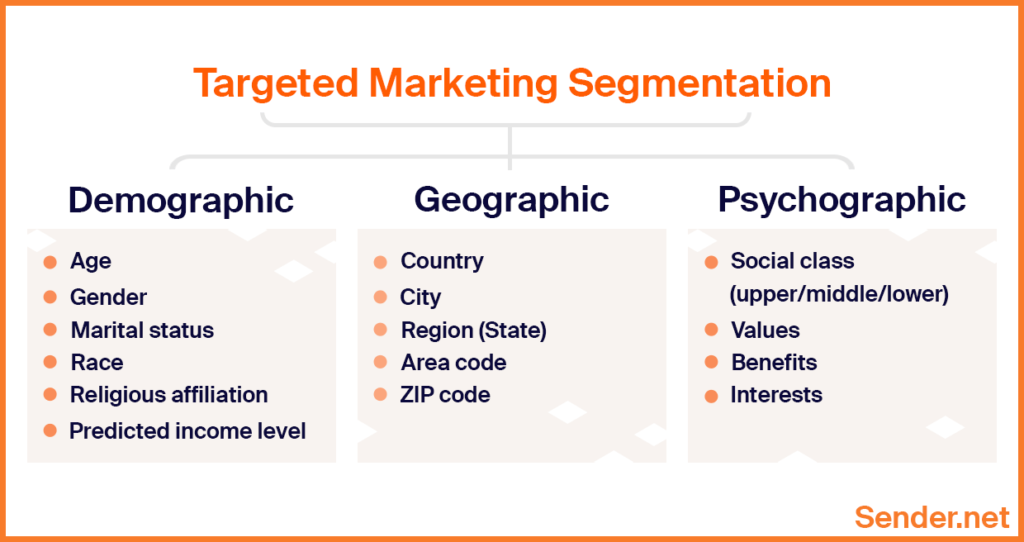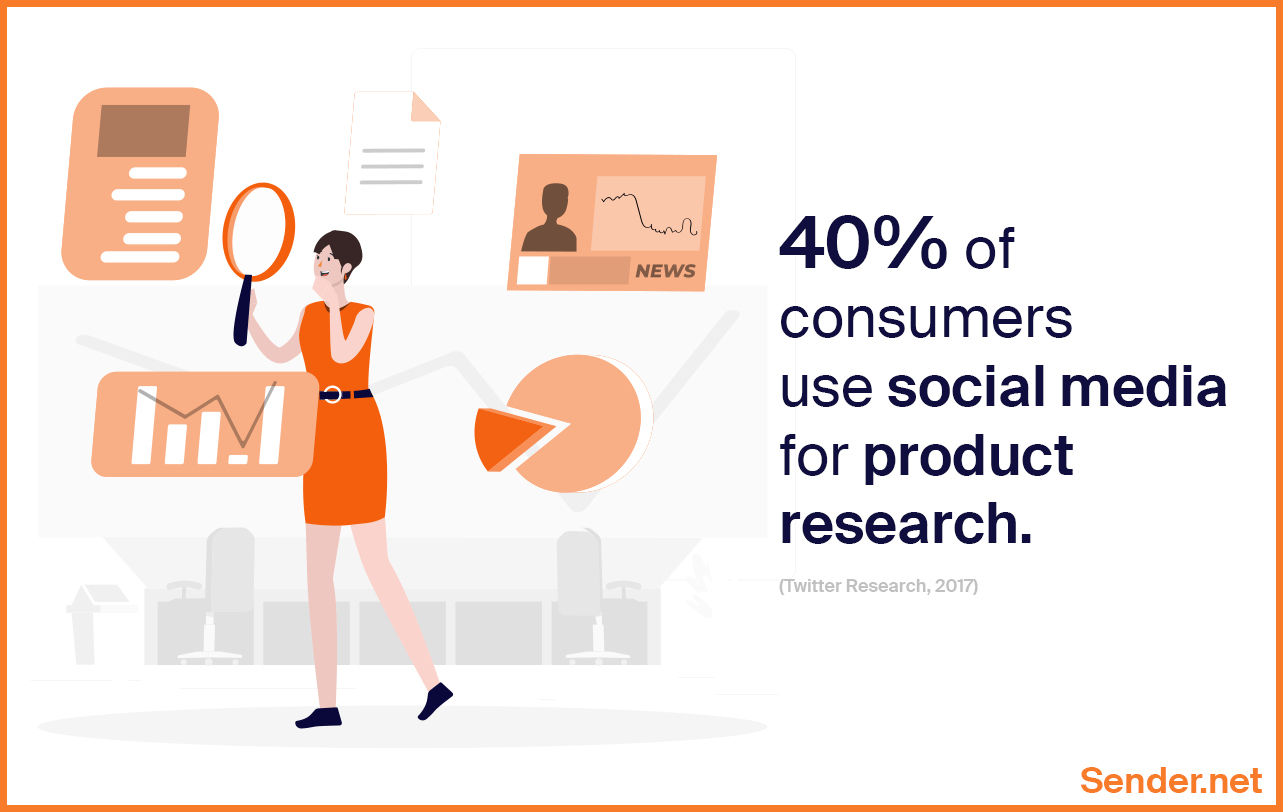Targeted marketing, by definition, is the strategy of tailoring and personalizing online advertising according to data acquired from some intended audience.
In other words, instead of sending out ads to an incredibly large audience, a subset is selected based on their traits, interests, and preferences.
Of course, targeted marketing has numerous associated benefits. After all, you’re basically sending advertisements to people who are highly likely to be interested in them. It’s hard to fail such a strategy.
In fact, targeted marketing is the preferred strategy by consumers. When allowed to pick between random or targeted advertisements, over 40% prefer the latter, and 27.6% prefer either.
Additionally, behavioral-data-based ads were shown to be the most effective – their clickthrough rate was up to 5.3x higher when compared to other approaches.
Is Targeted Marketing Ethical?
Usage, storage, and collection of data have gotten a lot of buzz over the past years. With all the new legislation, such as GDPR and CCPA, internet users and legislators looked towards clamping down on the use of personal data.
Unfortunately, without some measure of personal data, targeted marketing would be impossible. It is fully based upon the large amounts of data your or other businesses have collected on customers.
Yet, in most cases, targeted marketing will be ethical. Users now have a lot of tools regarding the control of their personal data. They may ask for all data to be deleted, or they can reject cookies and targeted advertising altogether when visiting a web page. Thus, the legal and ethical dangers of targeted advertising are mostly overblown.
If a person provides consent for their data to be collected and used, there are hardly any ethical questions left. Add the fact that most consumers enjoy receiving targeted advertising, and you get clear solutions to all the ethical questions.
Importance of Segmentation in Targeted Marketing

As mentioned previously, all targeted marketing relies on segmentation. Audiences are separated according to specific criteria, and advertisements are tailored to each. Of course, with enough data, the audiences can become extremely detailed and narrow. However, it is often recommended to avoid hyper-targeted marketing.
Market and customer segmentation can be approached in a multitude of ways. However, there are three primary ways to split audiences. Marketers and business owners should create segments based on demographics, geographics, and psychographics.
One of the best ways to target customers or prospects is through email marketing.
Take your marketing to the next level with targeted campaigns your audience will care about.

Demographic Segmentation
One of the most basic and obvious ways to segment large amounts of people. Demographic segments usually categorize audiences based on:
- Age;
- Gender;
- Marital status;
- Race;
- Religious affiliation;
- Predicted income level.
While demographic segmentation is extremely basic, it does have a lot of benefits. For example, there are certain hobbies or activities that are statistically preferred by a specific age or gender brackets. As a result, age or gender-targeted advertising can be effective for certain business models.
Additionally, people in different age brackets react to content differently. A great example is the tone of your website. If your intended audience is 18-25 years old, your content and marketing practices will be wildly different than if your intended audience is 35-45 years old.
Geographic Segmentation
Geographic (or geo) segmentation is, as the name says, the practice of splitting audiences according to location-based data. Such segmentation is extremely important if your business ships or delivers physical products. Usually, you’ll need data such as:
- Country
- City
- Region (State)
- Area code
- ZIP code
With geo segmentation, you’ll be able to target customers with local advertising or location-based discounts (e.g. free shipping).
Psychographic Segmentation
One of the most advanced types of segmentation, psychographic, looks at socioeconomic factors and correlated preferences. However, in order to properly apply psychographic segmentation, a lot of data is required. Usually, these segments will include:
- Social class (Upper/middle/lower)
- Values
- Beliefs
- Interests
You may not have access to all of the data points listed above, or you may have access to more. Nevertheless, psychographic segments are useful to retailers and businesses selling many lifestyle-driven items.
Targeted Marketing Strategies and Examples
Before we get into the particularly targeted marketing strategies, one important thing to note is that all strategies depend on data. If you can’t acquire lots of in-depth data on your target audience or are lacking in the analytics department, targeted marketing will be significantly harder.
Targeted Email Marketing
When it comes to online marketing, emails are an essential part of the process. In fact, companies will often begin their targeted marketing campaign by considering the email channel first.
Like all other approaches to targeted marketing, campaigns begin with email list segmentation. You can’t send highly targeted messages if the audience isn’t separated according to certain criteria. That’s where data will come in.
If you run an e-commerce store, some of your shoppers might prefer a particular type, color, or size of the product. Gathering data on all these preferences will allow you to build highly targeted messages for each segment, which will, of course, result in more and better leads.
Also read: What is a Trigger Email? Definition, Types & Examples
Targeted SMS Marketing
Targeted SMS marketing is really no different from all the other strategies. However, it might be significantly more effective than many other marketing channels. We have described the incredible effectiveness of SMS campaigns in our previous articles.
Yet, it would be most efficient to build a consistent user profile from data acquired in email marketing (and other channels). SMS marketing is not as conducive to producing data as there’s barely any tracking available for it.
Additionally, it’s usually a very responsive and quick channel, which might skew certain datasets (e.g. shopping behavior might be different, but the differences might be due to the channel itself, not the users).
Of course, targeting users with SMS marketing is a boon to many industries. One of the few industries where it’s most effective is ecommerce and retail. As the industries have a ton of data on customers, they can create custom, tailored SMS messages that will truly resonate with the intended audience.
Additionally, ecommerce and retail are heavily driven by sales and promotional messages as they are B2C businesses with largely low-cost items. As a result, people can be easily drawn in by small deals or discounts. Adding targeted SMS messages into the mix will likely end in resounding success.
Targeted Social Media Marketing

Social media is where targeted digital marketing gets a little complicated but interesting. There isn’t a lot of overarching strategy to it, as the way customers use social media differs greatly between platforms. Yet, it’s important to note that over 40% of consumers use social media for product research. Therefore, social media is the perfect candidate for targeted marketing.
On many platforms, such as YouTube, Twitter, or Pinterest, audience targeting will be different. Essentially, for targeting, you can only use the data provided by the platform to deliver digital advertising. You can incorporate internal data into social media marketing in general, however, with targeting, it’s a little different. You’re best off not matching audiences, as social media gives you access to much wider ones.
As a result, you might need to approach segments differently. Social media can be used primarily for retargeting (as support for other channels). It can, however, also be used on its own. In these cases, your approach should be to create a combination of demographics and interest in order to reach the intended audience.
Facebook and Instagram Marketing
Facebook provides as much data as you need to get your marketing plan going. The types of data on offer are:
- Gender
- Interests
- Relationship Status
- Occupation, as well as job title targeting
- Educational Status
- Age
- Language
- Location, including if someone lives in an area or just visiting
They also provide even narrower targeting such as birthday targeting. Additionally, Facebook is integrated with Instagram, which provides an opportunity to target the same user over several platforms. With all the customization Facebook marketing provides, everyone can perform effective segmentation and targeted marketing.
LinkedIn Targeted Advertising
LinkedIn provides much the same as Facebook and Instagram. They do, however, have a very different overall audience. In fact, the same ads that work on Facebook and Instagram likely won’t work as well on LinkedIn.
LinkedIn is mostly used by professionals for business or work purposes, so the tone is very different on the page. Due to the business-related nature of the platform, LinkedIn is highly favored by B2B companies because it provides access to higher-quality leads.
As a result, your targeted marketing strategy should be a little different on LinkedIn. Segment the audiences based on industries and professions. If you already have buyer persona’s built, marketing to these buyers will be most effective.
LinkedIn also cautions against hyper-targeted marketing. With enough data, audiences can be narrowed down to only several hundred people. Yet, such narrow targeting is unlikely to be as successful as targeting a wider but less ideal audience. Restrictions are there for a reason. LinkedIn themselves recommend keeping about 50 000 people in every audience.
Targeted Content Marketing
Targeted content marketing can be conducted passively and actively. Passive targeted content marketing is done by a lot of businesses who have a blog. On-site content revolves around the interests, pain points, and challenges of their buyer personas.
Active marketing works by creating highly specific pieces of content that may then be distributed through different channels. For example, using account-based marketing and sending white papers would be an example of active content marketing.
It should be noted, however, that the goal of the content is to get people into the sales funnel. Therefore, it should not only be directed at specific buyer personas, but also reveal some form of benefit that can be derived by using your products or services.
Google Ads Targeted Marketing
In Pay-Per-Click (PPC) ads, segmentation and targeting is king. A lot of the strategies, segments, and approaches to targeted marketing can be derived from PPC.
Of course, Google Ads has long been the primary asset of PPC targeted marketing. As it can reach the widest audiences and has (or at least used to have) the most in-depth and granular data, marketers could do a lot with simple ads. In fact, Google Ads have been so powerful that they even are used for highly advanced strategies such as reminder and reinforcement advertising.
As most digital businesses already use or have used Google Ads, a lot of the strategies, segments, and approaches to advertising can be lifted and moved to other channels. For example, PPC can help content build good buyer personas and provide data to email marketers. In fact, readapting Google Ads targeted marketing strategies to other types of targeted marketing might be the easiest way to get the most benefit out of such an approach.
Apply Targeted Marketing Campaigns in Practice
Targeted marketing should be included in all digital businesses. Most already do that through the use of PPC advertisements such as Google Ads. However, data can be integrated into other marketing channels in order to take advantage of targeted marketing in those areas.
Want to make email and SMS-targeted marketing easy? Sender.net gives you the opportunity to send personalized and targeted messages through both channels without breaking the bank. You can even start free with up to 2 500 subscribers and get all of our features.
Also read:
